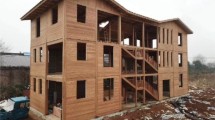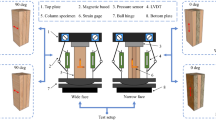Abstract
Densified lamellas of bamboo Guadua angustifolia Kunth (Guadua) were arranged orthogonally and glued together to form three- and five-layer cross laminated (XLam) panels with symmetrical compositions, which are refereed as G-XLam3 & G-XLam5, respectively. This XLam composition is typical of plywood and cross-laminated timber (CLT) panels, hence analytical design methods developed for these systems have been applied to analyse the structural performance of G-XLam panels. For structural analysis G-XLam panels were considered as multi-layered systems composed of contiguous lamellas with orthotropic axes orientated at 0° and 90°. Timber engineering methods normalized by international standards were used in this study for the prediction of the mechanical properties of G-XLam panels. Bending stiffness properties of these panels were predicted using the transformed cross section method to find the modulus of elasticity of beams from the moduli of elasticity of the individual layers. As the elastic properties of the laminate system depend on the elastic properties of the individual layers, the elastic parameters for small clear specimens obtained in previous studies were used for the numerical analysis of G-XLam panels. Furthermore, compression stiffness and shear stiffness of the G-XLam panels were also calculated. Compared to test results and finite elements (FE) models undertaken prior to this study, analytical values provided a reasonably accurate prediction of the elastic properties of G-XLam3 and G-XLam5 panels. Differences in the results are assumed to be caused by manufacture flaws and thickness variation within the individual lamellas. Overall, this study showcases the potential of using timber engineering methods for the structural analysis of novel engineered bamboo products as well as their potential for structural applications. This design method also enables the design and analysis of novel composite laminated structures combining the high density and high axial stiffness of densified bamboo lamellas with low grade softwood or low-density core materials.
Access this chapter
Tax calculation will be finalised at checkout
Purchases are for personal use only
Similar content being viewed by others
References
Archila, H.F., Brandon, D., Ansell, M.P., Walker, P., Ormondroyd, G.A.: Evaluation of the mechanical properties of cross laminated bamboo panels by digital image correlation and finite element modelling. In: Salenikovich, A.J. (ed.) WCTE 2014, World Conference on Timber Engineering, Quebec, QC: WCTE 2014, p. 8 (2014). ISBN 978-086488560-9
Archila, H.F., Rhead, A., Ansell, M.P., Walker, P., Lizarazo-Marriaga, J.: Elastic response of cross-laminated engineered bamboo panels subjected to in-plane loading. In: ICE Proceedings: Construction Materials, pp. 1–12 (2017). https://doi.org/10.1680/jcoma.16.00080
Archila, H.F., Ansell, M.P., Walker, P.: Elastic properties of thermo-hydro-mechanically modified bamboo (Guadua angustifolia Kunth) Measured in Tension, Key Engineering Materials, CH, 600, pp. 111–120 (2014). https://doi.org/10.4028/www.scientific.net/KEM.600.111
Blass, H.J.: Timber engineering. - 1 : Basis of design, material properties structural components and joints. Almere, The Netherlands: Centrum Hout (1995)
Blass, H.J., Fellmoser, D.P.: Design of solid wood panels with cross layers. In: 8th World Conference on Timber Engineering, vol. 14, pp. 1001–1006 (2004)
Bodig, J., Jayne, B.A.: Mechanics of Wood and Wood Composites. Reprint edn. Van Nostrand Reinhold Company, New York (1982)
BSI: BS EN 12369-3:2008, Wood-based panels—Characteristic values for structural design. London, UK (2008)
BSI (2016) BS EN 338: 2016 Structural timber—Strength classes. London, UK
BSI: BS EN 408:2010, Timber structures—Structural timber and glued laminated timber—Determination of some physical and mechanical properties. London, UK (2010)
BSI: BS EN 14272:2011, Plywood—Calculation method for some mechanical properties. London, UK (2011)
BSI: BS EN 1995-1-1:2004 +A2:2014, Eurocode 5: Design of timber structures—Part1-1: General -Common rules and rules for buildings. London, UK (2014)
Ceccotti, A.: New technologies for construction of medium-rise buildings in seismic regions: the XLAM case. Struct. Eng. Int. 18(2), 156–165 (2008). https://doi.org/10.2749/101686608784218680
Gagnon, S., Pirvu, C.: CLT Handbook - cross laminated timber. Canadian. Edited by Sylvain Gagnon and Ciprian Pirvu. FPInnovations, Québec (2011)
Marcroft, J.: Concise Eurocodes: Design of Timber Structures. BS EN 1995-1-1: Eurocode 5. London, UK (2012)
Mayr-Melnhof Kaufmann Group: Manual Cross-laminated timber panels M1 BSP cross plan. Gaishorn am See, Austria (2009)
Okabe, M., Yasumura, M., Kobayashi, K., Fujita, K.: Prediction of bending stiffness and moment carrying capacity of sugi cross-laminated timber. J. Wood Sci. 60(1), 49–58 (2013). https://doi.org/10.1007/s10086-013-1377-8
TRADA: TRADA Technology Guidance Document 10 (GD10) Cross-laminated Timber (Eurocode 5) Design Guide for Project Feasibility. High Wycombe, UK (2009)
Acknowledgement
The authors are grateful to MINCIENCIAS, for the financial support provided to Amphibia Group SAS (Colombia) for the project ‘G-XLam Hybrid: Sistemas laminados híbridos de Guadua para construcción prefabricada’ part of the postdoctoral programme (Convocatoria No. 784-2017 Estancias Postdoctorales 2017).
Author information
Authors and Affiliations
Corresponding author
Editor information
Editors and Affiliations
Rights and permissions
Copyright information
© 2023 The Author(s), under exclusive license to Springer Nature Switzerland AG
About this paper
Cite this paper
Archila, H.F., Zea-Escamilla, E., Harries, K. (2023). Structural Analysis of Cross-Laminated Guadua-Bamboo (G-XLam) Panels Using Design Methods for CLT. In: Amziane, S., Merta, I., Page, J. (eds) Bio-Based Building Materials. ICBBM 2023. RILEM Bookseries, vol 45. Springer, Cham. https://doi.org/10.1007/978-3-031-33465-8_72
Download citation
DOI: https://doi.org/10.1007/978-3-031-33465-8_72
Published:
Publisher Name: Springer, Cham
Print ISBN: 978-3-031-33464-1
Online ISBN: 978-3-031-33465-8
eBook Packages: EngineeringEngineering (R0)




